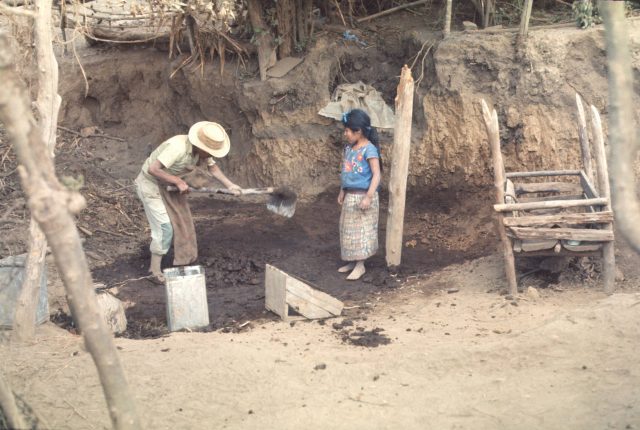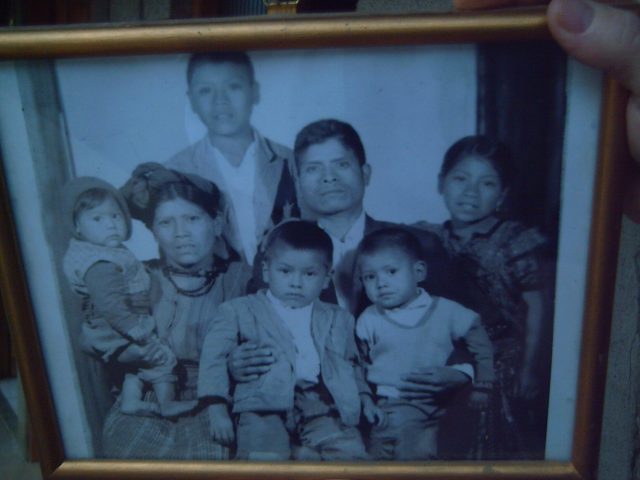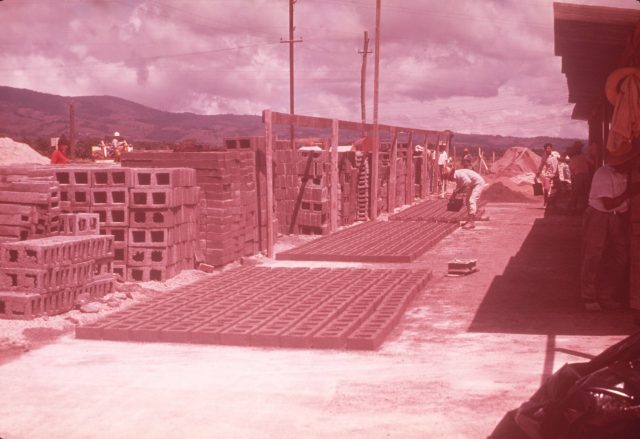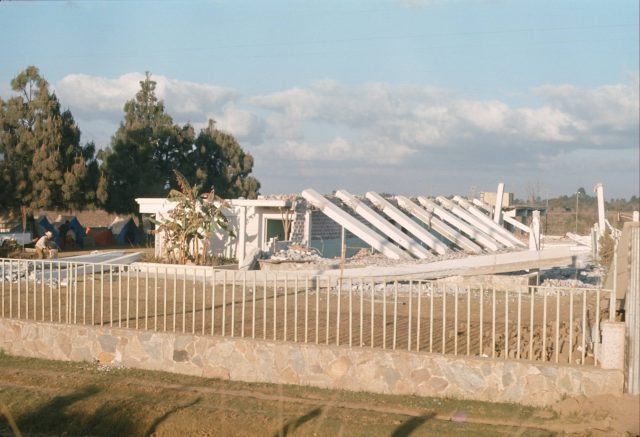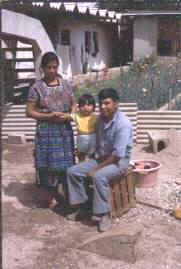Latter-day Saint Missionaries in the Guatemala Earthquake of 1976
by Larry Richman
This is part 2. Read part 1 of the story.
Work Camp Patzicía
We set up a camp of tents around the church in Patzicía and sixteen missionaries spent the next two months in jeans and t-shirts working with shovels and picks helping the people clear out their sites to make way to build new houses. We were anxious to get the members into houses before the rainy season began in just a few months. We hauled out the old adobe bricks, took apart the roofs, and stacked the timbers and corrugated metal sheets.
Sundays were spent in church and other meetings to organize work parties, but the other six days a week we left camp at 6:30am and returned dusty and dirty at 5:00pm. We would then bathe, eat, and go to bed. One morning, for example, three of us worked at a man’s house carrying 35-pound adobe bricks on our shoulders from the house, 110 feet to the road where we dumped them. During the five hours we were at his house, we moved about 32,000 pounds. One Elder commented that in all the years bucking hay on his dad’s farm, he had never worked harder in his life than he did here. We didn’t look for praise from our parents or from the mission president; we worked because we loved the people and wanted to help them.

How to tear down an adobe wall: Step 1. Elder Larsen and Elder Richman chipping the plaster off a wall.

Elder Warnock (on the left) and Elder Larson (on the right) tear down damaged walls after the earthquake in Guatemala 1976
Each preparation day (Monday) for two months after the earthquake, the Guatemala City Zone and the Quetzaltenango Zone joined us to work in mass in a town to help members and nonmembers alike. Read about the missionaries working in towns on their preparation days in the article “Elders Help Rebuild Guatemala” from the Church News.

Missionaries stopping for a watermelon break on the road out of Comalapa after the work day. (Elders Evans, Choc, and Frischknecht in foreground)
We (about 4 elders) went to Guatemala City on February 23, 1976 after the Comalapa work day and spent the night in the Ritz Continental Hotel, 6a Avenida “A” 10-13 in zone 1. The hotel was not badly damaged in the earthquake. It was strange to sleep again indoors, worried that heavy walls might fall on us during one of the tremors that were still occurring.
a>

Elders Argueta and Richman behind the Patzicía church. See alternate photo.
See the page Where are they today?

Elder Wait, Elder Worthington, Elder Bernhardt, Sister Powell, Brother Powell, Elder Howard, Sister Sharp, Elder Schmolinger, Sister Hyer, and Elder Warnock.
For part of the two months of Camp Patzicía, another missionary and I took care of the camp during the day. One day for example, we saw a calf born, killed six chickens, hauled several hundred gallons of water up from the well, distributed food and clothing to people who showed up at the church, washed the morning and evening dishes, cleaned the kitchen, dining room, tents, and camp, sorted the clean clothing and delivered it to each tent, ran some errands in town, and moved a piano and some other things from the rooms in the church.
One day when Greg Martin and I were in the camp, a helicopter landed in the field next to the church. A man came running out of the helicopter and asked “Did you get the powdered milk from Candada?” It seemed an odd question, since we didn’t know anything about milk from Canada.

Elder Kelly Robbins’ birthday. Elder Howard, Sister Johnson, Sister Wheatly, Elder Robbins, and Elder Richman
We continued to have tremors several times a day. No one sleeps under anything heavier than paper, cardboard, or cloth. We often wondered if a larger quake would come as they experienced in the town of Antigua many years ago. A quake knocked down buildings and killed people, but three weeks later an even larger quake hit which completely destroyed the town.
For a few weeks, the Guatemalan National Observatory installed a seismograph in town. It measured tremors of up to 3.5 on the Richter scale. They come from near the surface, which means the ground is moving and unstable. The center of the activity is about four miles south of Patzicía, near the volcano Fuego.

Services inside the temporary church where meetings were held in Patzicía, Guatemala until the new chapel was rebuilt
>
Sister Arcadia Miculax Secay (daughter of Mateo Miculax and Petronilia Secay) was the Relief Society president in Patzicía and she died in the earthquake, along with her baby Baudilio. Her husband, Ricardo Cua Itzol was not a member. But the urgency of the earthquake helped him decide to get baptized.

Elder Richman preparing to confirm Ricardo Cua a member of the Church on the banks of the river Balanyá on February 12, 1976.

Elder Richman confirming Ricardo Cua a member of the Church on the banks of the river Balanyá on February 12, 1976.
Brother Ricardo Cua later died in an accident in mixing pesticides. Elder Larry Richman and Elder David Frischknecht performed the temple work for him and his wife, Arcadia Miculax Secay, on July 18, 1979. See the family genealogy sheets and letter about the temple work.

President Robert B. Arnold in Patzún to discuss the housing reconstruction project with the members. (Also shown: Eber Caranza, Gary Larson, D Warnock).
Since most of the members had no financial means (savings or the ability to borrow money) to reconstruct homes, the Church came up with a plan to help them. President Robert B. Arnold in Patzún to discuss the housing reconstruction project with the members. (Also shown: Eber Caranza, Gary Larson, D Warnock).
Signs like this printed on cardstock began appearing:
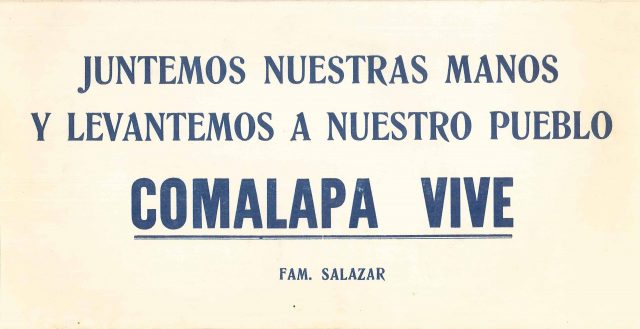
Juntemos nuestras manos y levantemos a nuestro pueblo. Comalapa vive. (“Let’s join our hands and raise our town. Comalapa lives.”)
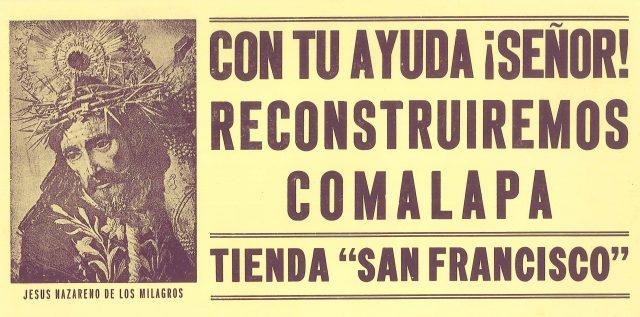
Con tu ayuda ¡Señor! reconstruiremos Comalapa. (“With thy help Lord, we will reconstruct Comalapa.”)
Elder Daniel Choc Xicay
A tribute to a man who sacrificed all to share the gospel. Elder Daniel Choc Xicay was the first full-time Latter-day Saint missionary from the town of Patzicía and the Church’s first native Cakchiquel-speaking missionary.

Branch president Pablo Choc, his sons Elder Daniel Choc and Austin Choc, and Elder David Frishknecht behind the fallen church in Patzicía after most of the rubble was removed.
Sister Powell wrote: “Our dear Branch President Pablo Choc who lost his wife and two little sons in the quake goes about his duties with a smile on his face. But when we are alone and talking, he says, ‘Oh, Hermana, I miss my wife so much. My home is so sad. I just hope that I can live worthy and work in the church so that I can be with them again. This life isn’t too long. We just have to go on and do the best we can.’ His son, Daniel, the first Cakchiquel Indian to go on a full-time mission came to our tent the other night. He is here with the other missionaries working. He said, ‘I just can’t believe that my mother is dead. It is so sad for me, but it is much sadder for my little sisters. They need her so much.’ But he goes along each day in his missionary work laughing with the other missionaries. Perhaps they don’t know the pain that is in his heart.” (Excerpts from “February 4, 1976: We Were There,” an unpublished account by Gladys Powell.)
As mentioned previously, each Monday for two months after the earthquake, all the missionaries from several zones joined us to work in mass in a town to help people clean up and prepare for rebuilding. The last Monday of the camp was March 29, 1976, and were were working in the town of Patzún. After this, we were to break the work camp and go back to regular missionary work.
Several missionaries were picking away at the bottom of a 15-foot wall (similar to the one pictured above) when it gave way prematurely and fell.
Everyone scrambled to safety, except for Elder Daniel Choc who was crushed by a four-foot section of brick and cement. Elder Warnock gave him artificial respiration while he was rushed to a nearby school that had been converted into a hospital. But the Lord soon called him home.
We thought we had seen the end of death from the earthquake two months before that, but now it took another life that was dear to us. All we could do was ask ourselves, “Why was it him under that wall and not me?” In spite of the difficulties he had in his life, Elder Choc was always happy and was a good friend to us. He was also an asset to the mission, being the only native Cakchiquel missionary. He patiently taught us to understand his people and speak their language.
We put his dear body in a pickup truck, and Elder Boyce Lines, Elder D Warnock, and I took him to Patzicía. The branch president Pablo Choc, Daniel’s father, was at the Patzicía church when we arrived. President Choc had experienced nearly the tests of Job, but remained strong and true. He is one of the most noble, dignified, and humble men I know. He and his wife had given birth to ten children, and she was expecting her eleventh when she was killed in the earthquake. Pablo was then left with six living children.
The mission president and I prepared Daniel’s body and placed it in the casket. He was only about 5′ 2″, but he was a giant of a man in my eyes. We left on the lapel of his suit the button he wore which read “Por sacrificio se dan bendiciones” (Blessings come through sacrifice).

Carrying Daniel Choc’s coffin to the cemetery. Missionaries pictured (from left to right): Elders Bernhardt, Frischknecht, Robbins, Salazar, Fulgencio Choy, and Elder Howard (front right of coffin).
I can only imagine the feelings of a father who sent his son on a mission and then lost his wife and 3 children in the earthquake. I can only image the faith it took for him to be strong for his family—and for all the other members of the branch, who also lost family. Then I can only imagine the agony two months later, when he lost his missionary son in this accident.
Through all these tests, President Choc remained strong and true. He is one of the most noble, dignified, and humble men I know. He and his wife had given birth to ten children, and she was expecting her eleventh when she was killed in the earthquake. Pablo was then left with only six living children.
The funeral services were held at Pablo Choc’s home on March 30, 1976. (See the funeral
program.) I spoke about the five weeks we were companions in Comalapa. During those five weeks he taught me things that I thought I already knew—like what love is and what dedication and commitment are all about. The most productive day of my mission was with Elder Choc. We taught ten discussions that day. As we knocked on doors to find those ten people to teach, and after being turned away at a door, Elder Choc would often run—not walk—to knock on the next door.
Elder Choc was deserving of two honors. He was the world’s first Cakchiquel missionary, and now he is the first Cakchiquel missionary in the spirit world. In Doctrine and Covenants 138:57, we read of the vision given to President Joseph F. Smith about the spirit world: “I beheld that the faithful elders of this dispensation, when they depart from mortal life, continue their labors in the preaching of the gospel of repentance and redemption, through the sacrifice of the Only Begotten Son of God, among those who are in darkness and under the bondage of sin in the great world of the spirits of the dead.”
Elder Choc’s casket was placed in a tomb which was built over the grave of his mother, two brothers, and the twelve other members of the branch that we buried on February 5th.

Elders Argueta, Larson, Robbins, and Richman at Daniel Choc’s grave. (See additional photo of Elder Gary Larson, Lynn Richman, and Elder Frischknecht by Elder Daniel Choc’s grave in August 1976 when my parents came to pick me up from my mission.)
On the front of his tomb is a marble headstone with the following inscription: “When ye are in the service of your fellow beings ye are only in the service of your God. Mosiah 2:17. Daniel Choc (Xicay). Born December 11, 1953. Died March 29, 1976. The first Cakchiquel missionary of The Church of Jesus Christ of Latter-day Saints who died serving his people.”
Each of us took time to sit by the grave and record our thoughts. See photos of Elder Argueta, Elder Larson, and Elder Richman.
I look forward to the day when I cross the veil and meet Elder Choc again with open arms, and I can thank him like I never really did in this life for his friendship and the example he showed me.
“It was impossible to get Elder Choc angry at you. You couldn’t argue with him either.” —Julio Salazar
“Elder Choc taught me through his example the true meaning of brotherly kindness, dedication, and consecration.” —Larry Richman
“He died in the service of the Lord while doing missionary work—fellowshipping and helping a nonmember. What better way to die!” —President Robert B. Arnold
“I have had the privilege to interview Elder Choc and to know the intimate details of his life. I assure you that Elder Choc left this world completely dedicated and completely pure.” —President Robert B. Arnold
“I just hope I’m in as good a shape when I die as Elder Choc was.” —President Robert B. Arnold
See the following articles in Church magazines about Elder Daniel Choc:
- “The Dedicated Daniel Choc,” Ensign, January 1979 (See PDF of the article). Read the article in Spanish (page 1, page 2, page 3).
- “Daniel Choc, First Cakchiquel Missionary,” New Era, April 1978
See telegram from Walter Matzer (our landlord in Comalapa).
Elder Choc’s girlfriend, Feliza Choy, was an inspiration of strength. She later served a full-time mission.
President Pablo Choc was an inspiration. Many people, both members of the Church and those who weren’t members, watched Pablo Choc to see how he would respond to these tragedies. His example of strength was an important reason the Church has grown so beautifully in Patzicía. I understand that about 10% of Patzicianos are Latter-day Saint. There was just one branch in Patzicía in 1976, and today (2015), there are four wards and a stake centered in Patzicía.
The Conclusion of Camp Patzicía
Camp Patzicía ended on March 31, 1976 and the missionaries who worked there were assigned to return to proselyting work in various towns. Read where these
missionaries are today.
Another group of 35 labor missionaries (local prospective full-time missionaries and BYU students) took over the tents and during a period of nine months, built over 250 small cinder block homes for the members. Read the article “Cementing Ties in Guatemala” (New Era, February 1977) about the workers who helped reconstruct homes. Also see “Rebuilding After Guatemala Quake.”
I have lived with the Cakchiquel people and seen them work and toil. I have helped them build their houses with bright hopes for the future, and then help them shovel away the debris after those hopes were destroyed in a 45-second earthquake. I have lived with them, prayed with them, sweat with them, and helped them bury their dead. I have shared their joy when I see success and progress.
For me the earthquake began as if a nightmare. I thought I was dreaming that I was trapped in bed. I thought I could wake up and everything would be all right. But I woke up to find the nightmare was a reality that shattered hopes and dreams. But the earthquake ended up being a cleansing of sorts. Towns have been rebuilt, new dreams have been born, and with a firm trust in God there is even more hope for a bright future.

Children in Patzicía playing with construction materials at the rebuilding of the church in Patzicía in 1978
This is part 2. Read part 1 of the story.















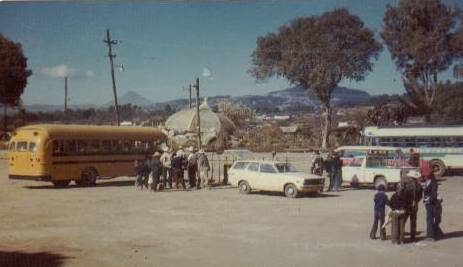

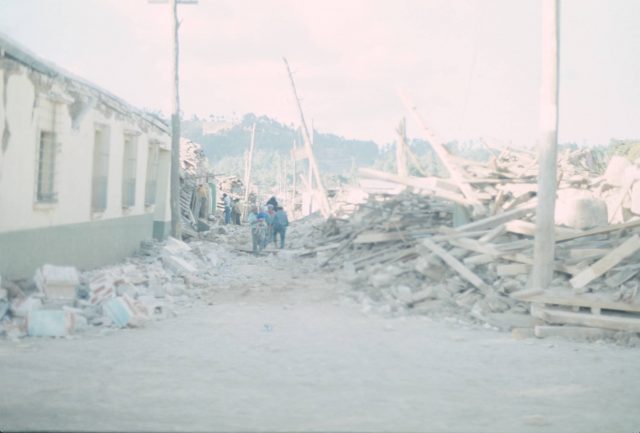


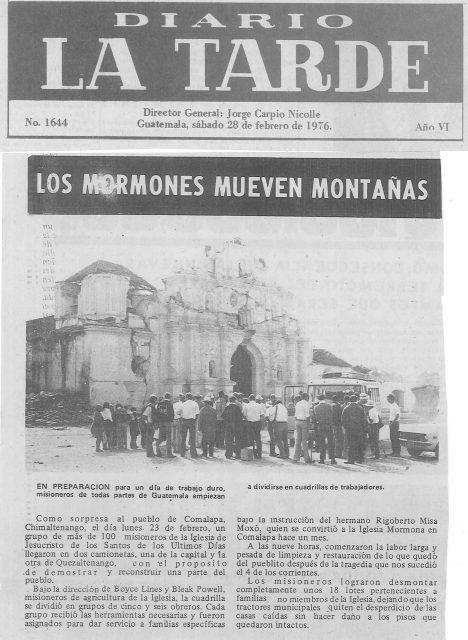

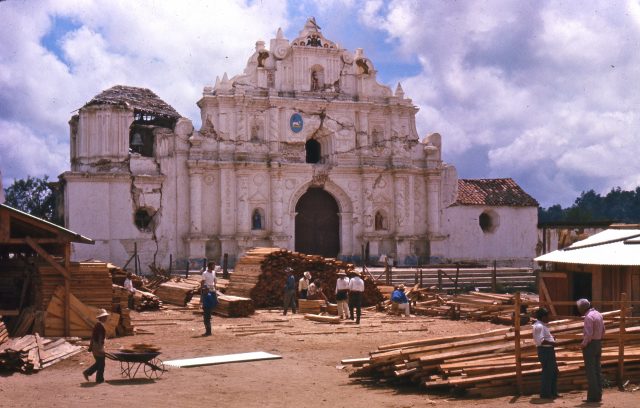









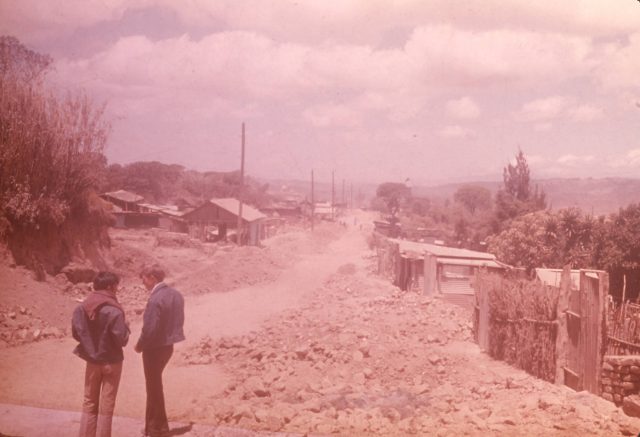












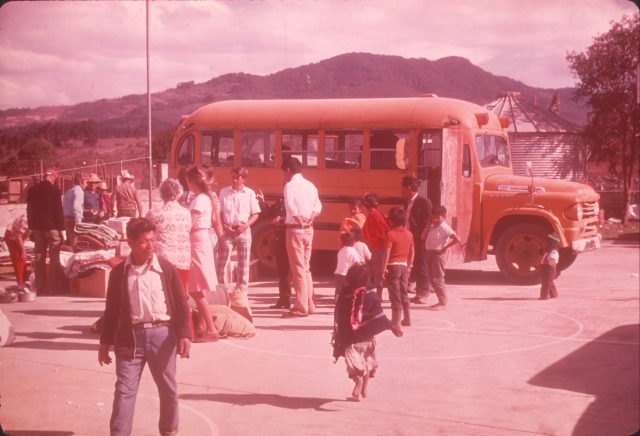

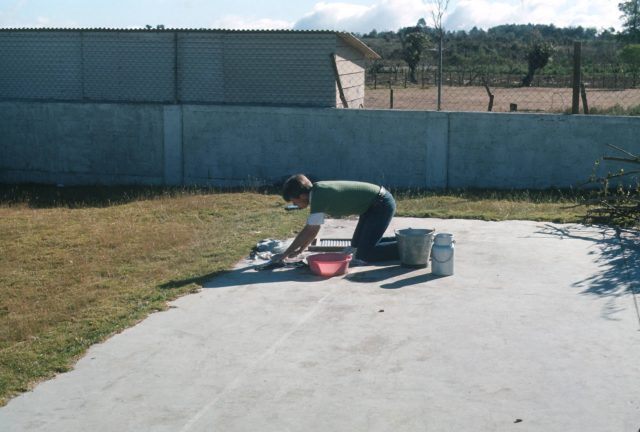
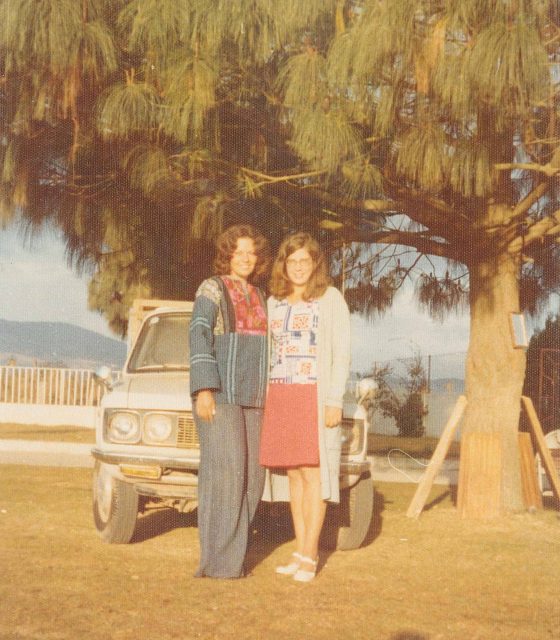



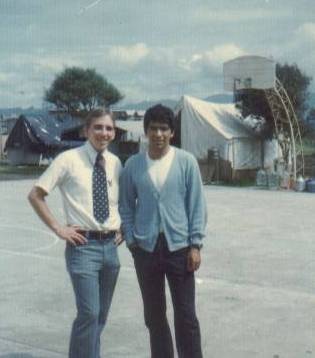






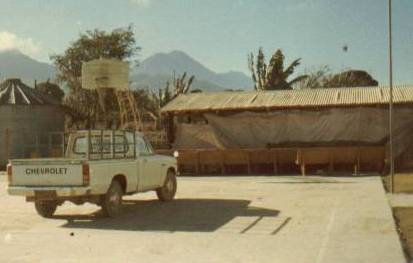

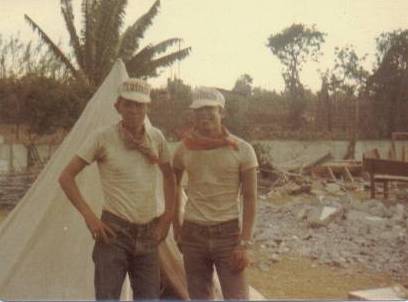






![Elder Choc baptizing [ ] in the river Balanyá on February 12, 1976](http://larryrichman.org/wp-content/uploads/Baptism-03-640x432.jpg)
